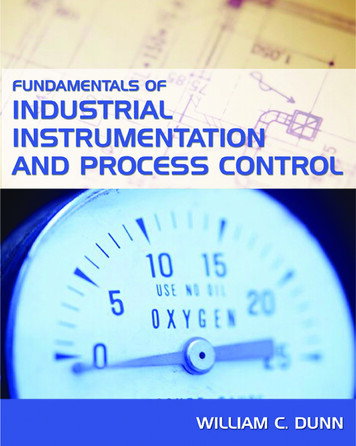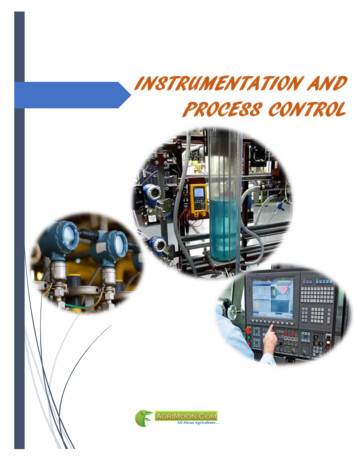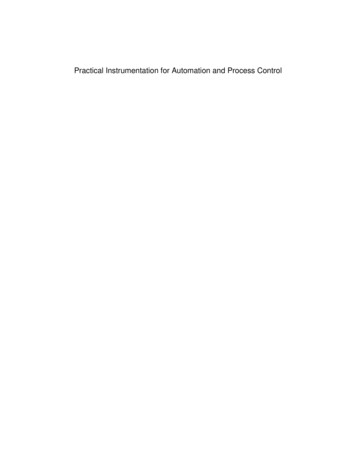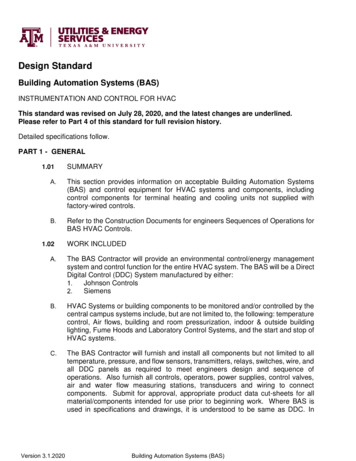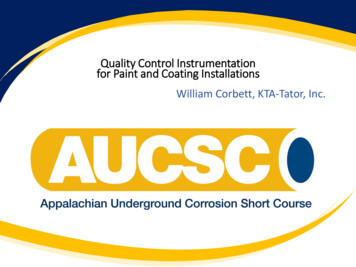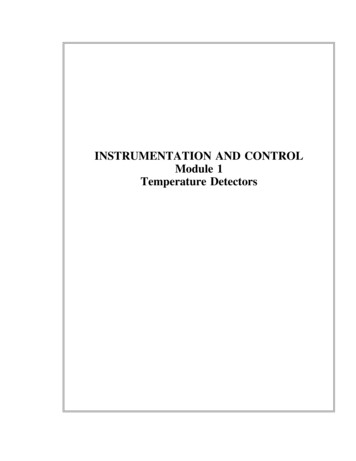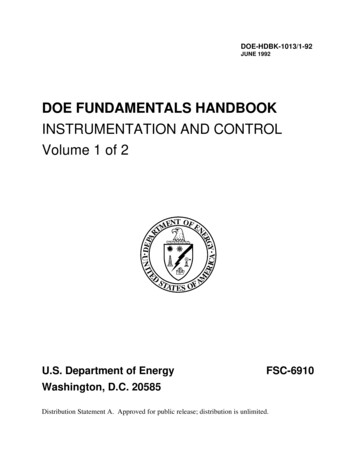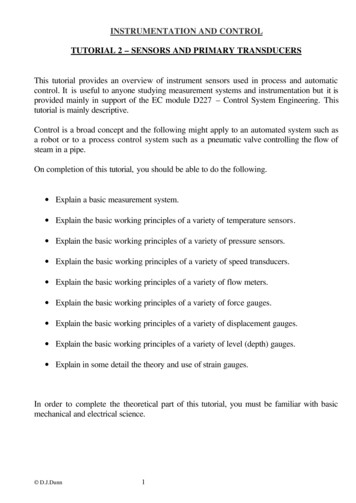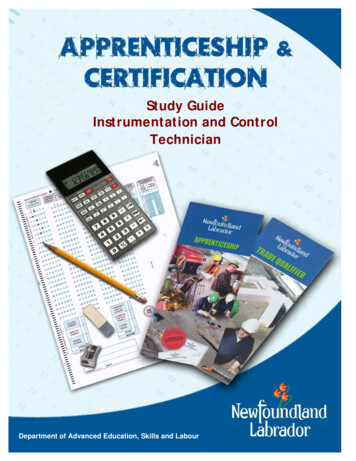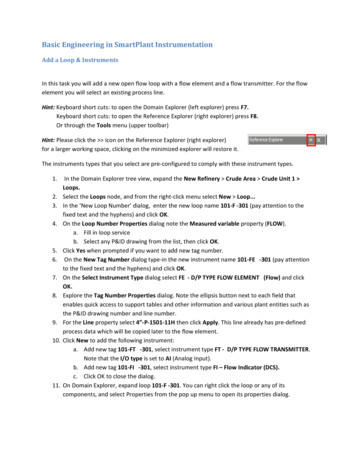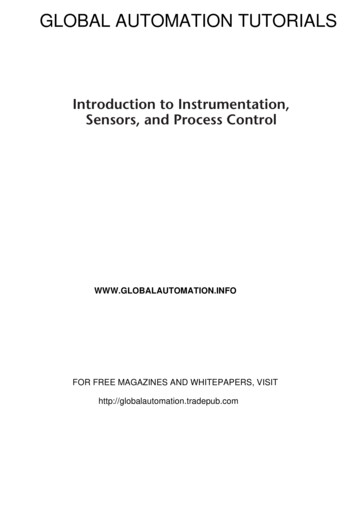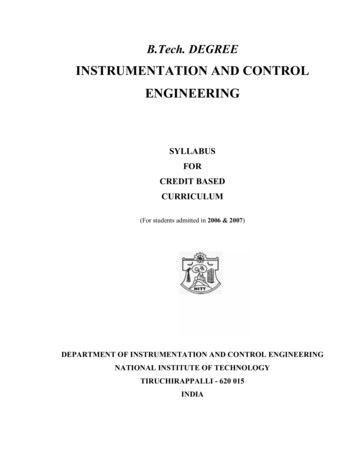
Transcription
B.Tech. DEGREEINSTRUMENTATION AND CONTROLENGINEERINGSYLLABUSFORCREDIT BASEDCURRICULUM(For students admitted in 2006 & 2007)DEPARTMENT OF INSTRUMENTATION AND CONTROL ENGINEERINGNATIONAL INSTITUTE OF TECHNOLOGYTIRUCHIRAPPALLI - 620 015INDIA
SEMESTER - IIICODECOURSE OF STUDYLTPCMA209Linear Algebra and Statistics3104IC 201Sensors and Transducers3003IC 203Circuit Theory3003IC 205Electron Devices3003CE 283Thermo Dynamics and Fluid Mechanics4004MT 211Material Science3003CE 285Thermo Dynamics and Fluid MechanicsLaboratory0031IC 207Circuits and Devices Laboratory0031Total191622SEMESTER - IVCODECOURSE OF STUDYLTPCMA202Numerical Methods3003IC 202Signals and Systems3003IC 204Industrial Instrumentation3003IC 206Analog Electronic Circuits3003IC 208Digital Techniques3104IC 210Data Structures and Algorithms3104IC 212Sensors and Transducers Laboratory0031IC 214Electronic Circuits Laboratory0031Total182622Department of Instrumentation and Control Engineering2
SEMESTER - VCODECOURSE OF STUDYLTPCIC 301Electrical and Electronic Measurements3003EC 317Principles of Communication Systems3003IC 303Microprocessors and Microcontrollers3003IC 305Linear Integrated Circuits3003IC 307Programming Tools and Techniques2204IC 309Control Systems3003IC 311Linear Integrated Circuits Laboratory0031IC 313Microprocessor and Micro-controllers Lab0031Total172621SEMESTER - VICODECOURSE OF STUDYLTPCIC 302Modern Control Theory3003IC 304Process Control3003IC 306Product Design and Development2042IC 308Introduction to MEMS and Nano technology3003IC 310Computer Networks3003IC 312Personal Computers and Interfacing Lab0031IC 314Control Engineering Laboratory0031IC 35XElective – 13003Total1701019Department of Instrumentation and Control Engineering3
SEMESTER - VIICODECOURSE OF STUDYLTPCIC 401Logic and Distributed Control Systems3003IC 403Analytical Instrumentation3003HM 401Industrial Economics3003IC 405Biomedical Instrumentation3003IC 407Instrumentation Laboratory0031IC 409Process Control Laboratory0031IC 411Product Design and Development0002IC 447Comprehensive Examination0003IC 45XElective - 23003IC 45XElective - 33003Total180625SEMESTER - VIIICODECOURSE OF STUDYLTPCIC 402Opto-Electronics and Laser basedInstrumentation3003MB 790Management Concepts and Practices3003IC 45XElective – 43003IC 45XElective – 53003IC 498Project Work00186Total1201818The total minimum credits required for completing the B.Tech. programme in Instrumentationand Control Engineering is 127 45 172.Department of Instrumentation and Control Engineering4
ELECTIVE LISTCODECOURSE OF STUDYLTPCIC 352Power Electronics3003IC 354Industrial Instrumentation Practices3003Elective - 1:Electives - 2 & 3:IC 451Automotive Control Systems3003IC 453Virtual Instrumentation3003EC 451ARM System Architecture3003EC 453Digital Image Processing3003CS 451Principles of Cryptography3003- Any one elective from other department electives can be taken.Electives - 4 & 5:IC 452Power Plant Instrumentation and Control3003IC 454Smart Materials3003EC 356VLSI Systems3003EC 464Display Systems3003CS 364Network Multimedia Systems3003- Any one elective from other department electives can be taken.Department of Instrumentation and Control Engineering5
RESERVE ELECTIVE LISTCODECOURSE OF STUDYLTPCEE 352Power Generation System3003EC 354Speech Processing3003HM 352Corporate Communication3003IC 455Optimization Technique3003IC 457Digital Control Systems3003IC 459Robotics3003IC 461Nano Technology3003IC 456Fault Detection and Diagnosis3003IC 458Neural Networks, Fuzzy Logic, and Control3003IC 460Piping and Instrumentation Diagrams3003IC 462Reliability and Safety Engineering3003- For VI, VII and VIII semester, electives given may be replaced by appropriate coursedepending on the student strength from the general electives.Department of Instrumentation and Control Engineering6
SUBJECTS OFFERED TO OTHER DEPARTMENTSIC 301Electrical and Electronic MeasurementsIC 216Instrumentation and ControlIC 218Control SystemsIC 220Instrumentation and Control LabIC 306Product Design and DevelopmentIC 315MechatronicsIC 317Mechatronics labIC 411Product Design and DevelopmentIC 413Instrumentation labIC 415InstrumentationDepartment of Instrumentation and Control Engineering7
MA209 LINEAR ALGEBRA AND STATISTICSLinear Algebra and Matrices – Vector spaces, Subspaces, Basis and Dimension - Systems of LinearEquations.Linear Transformations - Kernel and Image - Geometric Ideas - Inner Product spaces - Orthogonality- Orthonormal basis - Reflections and Orthogonal maps of the plane - Orthogonal complements andProjections.Bilinear, Quadratic, Hermitian, and Skew-Hermitian forms - Eigenvalues and Eigenvectors - CayleyHamilton theorem - Change of basis and diagonalization.Probability – Axioms of probability – Conditional Probability - Bayes’ theorem – Random variable –Density and distribution functions – Expectation – Jointly distributed random variables – Marginaland Conditional Densities.Binomial, Poisson and Normal distributions, Moment generating function, Characteristic function Chebyshev’s inequality - Law of large numbers.Computer based exercises are recommended in all the units.Text Books:1. Kumaresan, S.,“Linear Algebra: A Geometric Approach”, Prentice Hall of India, 2003,ISBN- 8120316282.2. Ross, S.M., “Introduction to Probability and Statistics for Engineers and Scientists”,2nd Edition, Elsevier, 2006, ISBN-1428814078.References:1. Hoffman, K., and Kunze, R.,“Linear Algebra”, 2nd Edition, 1992, Prentice Hall of India.2. Kreyszig, E., “Advanced Engineering Mathematics”, Rev, John Wiley, 2005.Department of Instrumentation and Control Engineering8
IC 201 SENSORS AND TRANSDUCERSGeneral concepts and terminology of measurement systems, transducer classification, general inputoutput configuration, static and dynamic characteristics of a measurement system, Statistical analysisof measurement data. Standards and Calibration.Variable resistance transducers: Potentiometers, metal and semiconductor strain gauges and theirsignal conditioning circuits, strain gauge applications: Load and torque measurement.Inductive transducers: Transformer type, synchros and resolvers, eddy current transducers, Hall effectsensors, proximity detectors, magnetostrictive transducers and capacitive transducers, tacho generator,stroboscope.Piezoelectric transducers and their signal conditioning, digital displacement sensors, photoelectrictransducers, basics of gyroscope, seismic instrument and accelerometers.Semiconductor sensor: Introduction, classification, and basic fabrication techniques.Text Books:1. John P. Bentley, “Principles of Measurement Systems”, 4th Edition, Addison Wesley Longman Ltd.,UK, 20042. Doebelin E.O, “Measurement Systems - Application and Design”, 4th Edition, McGraw-Hill, NewYork, 2003.3. S.M. Sze, “Semiconductor sensors”, John Wiley & Sons Inc., Singapore, 1994.Reference Books:1. Murthy D. V. S, “Transducers and Instrumentation”, Prentice Hall, New Delhi, 19952. Neubert H.K.P, “Instrument Transducers - An Introduction to their Performance and Design”, 2ndEdition, Oxford University Press, Cambridge, 1999.3. Patranabis, “Sensors and Transducers”, 2nd Edition, Prentice Hall India Pvt. Ltd., 2003.4. Waldemar Nawrocki, “Measurement Systems and Sensors”, Artech House, 2005.Department of Instrumentation and Control Engineering9
IC 203 CIRCUIT THEORYCircuit Analysis Techniques: Lumped circuits, Models of physical systems, Circuit elements,Network topology, Element and Circuit rules, Source transformations, Star-Delta Transformations,Nodal analysis, Mesh analysis, Principle of linearity, Network theorems and applications, Circuitswith controlled (dependent) sources.Transient Response: Application of Laplace transforms to circuit analysis, Circuits with capacitors,Circuits with inductors, Time-constant, Free and Step response of RC, RL, and RLC circuits.Sinusoidal Response: Behavior of elements with sinusoidal signals, Impedance and admittance,Circuit analysis using phasors, Sinusoidal steady state response of circuits, Magnitude and phase,Power and energy calculations, Three phase circuits, Resonance, Solution of A.C. steady statenetwork equations using complex frequency concept.Generalized Frequency Response: One- port and two- port networks, impedance and admittanceparameters, hybrid parameters, ABCD parameters, image impedance. State variables, Transferfunctions, Network functions - poles and zeros of network functions, Complex Frequency, scalingNetwork functions, Analysis of ladder network.Causality, Stability, Realizability of one port networks, Hurwitz polynomials, positive real functions,Reciprocal and symmetric networks, Conditions for existence of networks. Network Synthesis:Properties of RC, RL, and LC driving point functions, Synthesis of networks from given transferfunctions.Text Books:1. Hayt,W.H. and Kemmerly,J.E., “Engineering Circuit Analysis”, McGraw Hill, New York, 5thedition, 1993.2. Mahmood Nahvi, Joseph, A. Edminister, “Theory and Problems of Electric Circuits – Schaum’soutline series”, McGraw Hill International, 4th edition, 2003.3. Ramakalyan, A., “Linear Circuits: Analysis & Synthesis”, Oxford Univ. Press, India, 2005.Reference Books:1. Van Valkenburg, “Network Analysis”, 3rd Edition, Prentice Hall, New Delhi, 1998.2. D.Roy Chaudhry, “Networks and Systems”, New Age International Publishers, New Delhi, 1997.3. DeCarlo, R.A., & Lin, “Linear Circuit Analysis”, 2nd Edition, OUP Indian Edition 2003.Department of Instrumentation and Control Engineering 10
IC 205 ELECTRON DEVICESSemiconductor: Different semiconductor materials. Impurity doping. Intrinsic and extrinsicsemiconductors. Conductivity, Carrier concentration. Charge densities. Kronig – penny model. E-Krelation. Fermi level in semiconductors. Diffusion. Carrier life time. Continuity equation. Hall effectand its applications.P-N junction diodes: P-N junction diodes, Contact potential, Current components, Forward andreverse biased junctions, V-I characteristics, Equivalent circuits. Transition and diffusion capacitance.SPICE diode model, Metal semiconductor contacts. Hetero junctions. Zener diodes, Schottky diode,Photo diode, LED. Varactor diode. Breakdown diodes. Transferred electron devices. Hot electrondevices.BJTs: Basic BJT theory, Different modes of operation and configurations. Transistor currentcomponents. Ebers – Moll model and Gummel – Poon model of BJTs. Transistor α, Currentamplification β. Bipolar transistor switch, SPICE BJT model, Punch through and other breakdownmechanisms, Photo-voltic effect, Photo-cell transistors.MOSFETs: Device structure and physical operation, Current – voltage characteristics, MOSFETcircuits at DC, MOSFET as an amplifier and as a switch, Small signal model, MOSFET internalcapacitance and high frequency model, Depletion type MOSFET, SPICE MOSFET model, CMOSstructure, operation, BiCMOS operation, CCDs.Power devices: Thyristor family – UJT, SCR, TRIAC, DIAC – operation and V-I characteristics.Triggering. Power diodes, power transistors, IGBTs and GTOs fabrication and V-I characteristics.Text Books:1. S.M.Sze, “Semiconductor Devices, Physics and Technology”, 2nd Edition, Wiley, 2002.2. A.Bar-Lev, “Semiconductor and Electronic Devices”, 3rd Edition, PHI, 1993.3. L.Macdonald and A.C.Lowe, “Display Systems: Design and Applications”, John Wiley and Sons,2003.Reference Books:1. D.A.Neamen, “Semiconductor physics and devices”, 2nd Edition, Irwin, 1997.2. B.G.Streetman, “Solid state devices”, 4th Edition, PHI, 1995.3. D.A.Pucknell & K.Eshraghian, “Basic VLSI Design”, 3rd Edition, PHI, 1996.Department of Instrumentation and Control Engineering 11
CE 283 THERMO DYNAMICS AND FLUID MECHANICSBasic concepts:Thermodynamic equilibrium, quasi-static process, zeroth law, work and heatinteractions, first law for a cycle and a process, steady flow processes, second law statements,reversibility, Carnot theorem, Clausius inequality, entropy principle.Available energy: Availability and irreversibility, properties of pure substances, phase equilibriumdiagrams, Rankine cycle, reheat and regenerative cycle, properties of ideal gas, Stirling and Ericsoncycles.Heat engines: Otto, diesel and dual cycles, Brayton cycle with regeneration, inter cooling and reheat,Joule-Thompson effect. Classification of fluids and their physical properties, Fluid statics,manometers, pressure on submerged bodies.Ideal fluid – velocity field – stream line, streak line and path line, continuity equation – Rotational andirrotational motion, stream function and potential function, Eulers equations of motion, Bernoulli’sequation and its application. Classification of open channel flows – measurement of discharge usingrectangular and V notches.Dimensional analysis – Rayleigh’s method – Buckinghan π Theorem and its applications. Laminarflow – Losses – Hagen-Poiseuille equation - Turbulent pipe flow – friction Darcy weisbach equation –moody’s diagram, minor losses – Boundary layer and its basic concepts.Text Books:1. Zemansky, “Heat and Thermodynamics” 7th edition , McGraw Hill, New York, 1997.2. Streeter V.L. and Wylie E.B., “Fluid Mechanics”, 9th edition , McGraw Hill, New York, 1997ISBN 0070625379.Reference Books:1. Van Wylen,G.A.,etal, “Fundamentals of classical Thermodynamics”, 4th Edition, John Wiley &Sons, 1994.2. Cengal,Y.A., Bogles,M.A., Micheal Boles, “Thermodynamics”, 2nd Edition, McGraw Hill BookCompany, 1994.3. Nag,P.K., “Engineering Thermodynamics”, 2nd Edition, Tata McGraw Hill, 1995.4. ShamesI.H., “Mechanics of Fluids”, Third Edition, McGraw Hill, New York, 1992.Department of Instrumentation and Control Engineering 12
MT 211 MATERIAL SCIENCEIntroduction to crystal structure of materials: Miller indices, X-ray diffraction techniques, mechanicalproperties of materials, elastic, viscoelastic and plastic behaviour, stress-strain relationship, relaxationcreep, strengthening mechanisms and fracture.Defects in solids: Point, line and planar defects and their effect on different
Department of Instrumentation and Control Engineering 9 IC 201 SENSORS AND TRANSDUCERS General concepts and terminology of measurement systems, transducer classification, general input-output configuration, static and dynamic characteristics of a measurement system, Statistical analysis of measurement data. Standards and Calibration.
